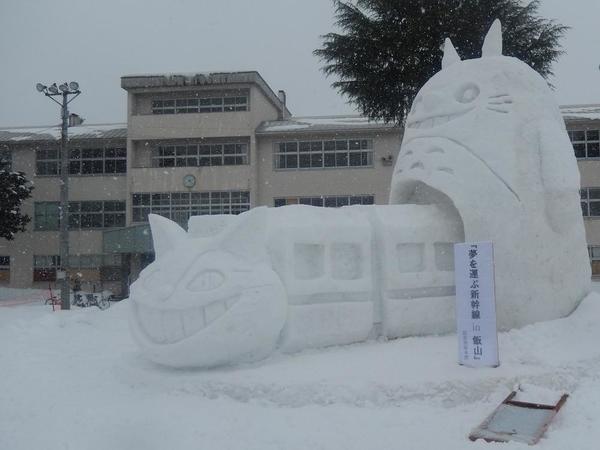Children ride a miniature Bullet Train during the Iiyama Snow Festival
Furusato. Japan’s Hometown. It’s the tagline splashed across the glossy magazines in Iiyama City’s new tourism office, located on the ground floor of the town’s bamboo-inspired train station. The station, too, is new. Built in 2015 as one of the final links in the Hokuriku Bullet Train line, it now connects Tokyo to the coastal city of Kanazawa on the opposite edge of Japan; a fact the workers in the tourism office take pride in, as well as hope.
For them, the furusato tagline isn’t just a marketing ploy. It’s a word that has defined and encapsulated their lives as residents of small-town Japan. Like most of the country’s rural cities (affectionately called furusato or “hometowns”), Iiyama has experienced a population drain over the last decade that has left swaths of the city either empty or inhabited by the increasingly elderly.
The bleakest numbers are seen among the demographic of young women (those ages 20 to 39), whose population declined 57.6 percent from 2010 to 2014—a phenomenon attributed to better college, job, and marriage prospects in Tokyo and its surrounding environs. (for details, see link at bottom)
People were quick to point out the ramifications of this statistic when I first arrived in Iiyama as a shiny, new English teacher. In fact, my second day in the city had me driving past an abandoned high school while my supervisor spoke about the student population crisis and how small my classroom sizes would be as a result.

Totoro stands outside an abandoned high school with the Bullet Train emerging from his belly. The sign reads: The Dream-Carrying
Shinkansen (Bullet Train) in Iiyama
“Much smaller than America,” she said before adding about the abandoned building, “Kawaisou, desu ne," which means, "Pitiable, isn't it?"
The high school I saw was only one of two that had closed over the last few years as part of a money-saving consolidation effort. This April will see the closure of yet another building—this time an elementary school—whose enrollment is just ten students. Unlike the high schools, this closure has come as a big blow to the surrounding community, since it’s believed areas without elementary schools won’t attract the young families needed to revitalize them.
Despite the closures, however, the residents remain hopeful, in large part because of the new station. The Bullet Train promises to bring with it an influx of new visitors—sightseers, vacationers, wealthy Tokyoites looking to escape the metropolis for a weekend—as well as jobs. It’s an opportunity few rural cities receive, and the Shinshuu-Iiyama Tourism Bureau is already busy trying to capitalize on it.
In conjunction with the City Office, the Tourism Bureau has made a big push to increase the profile of the city’s attractions. In addition to moving into their new premises, they’ve put on promotional tours, added services, and sunk money into slick, modern-looking marketing materials. They’ve even completely revamped their website, adding a professionally translated English portion aimed at enticing foreigners. Although the full results of their efforts won’t be seen for a few more years, the Tourism Bureau is confident in their slate of attractions. After all, Iiyama has quite a bit to offer.
Nestled between two mountain ridges along the Chikuma-gawa (also known as the Shinano River, the longest river in Japan), Iiyama is a natural haven for outdoor activities. Winter sports have traditionally been the city’s biggest draw, with a handful of world-class ski resorts, including some Olympic venues, within minutes of downtown. However, the Tourism Bureau’s website is mostly dominated by other seasonal activities, like river rafting, ziplining, cycling, camping, and mountain climbing. The mountain trails in particular are highlighted, and for good reason: Iiyama is the main launching point of the Shin-etsu Trail, a series of breath-taking and largely undisturbed historical trade routes running through the Sekida Mountain Ridge, which makes up the Nagano-Niigata prefectural border.
Trail leading to Kosuge Temple in Iiyama
I was fortunate enough to get invited on one of the Tourism Bureau’s promotional tours for the Shin-etsu Trail. A two-day hike, the tour featured some of the trail’s most diverse landscapes (the first day began with a steep climb to a mountain peak and ended with a trek through marshland on narrow wooden planks), as well as stereotypical “hometown” attractions, like staying in a family-run inn, wearing yukatas, and eating rice grown in spring-fed water. The tour was specifically tailored for foreigners who may have little experience with traditional Japanese culture, but it was also clear through conversations with our tour guide that the Tourism Bureau is hoping similar attractions will appeal to nostalgia-seeking Tokyoites as well.
For them, Iiyama truly is the epitome of the furusato lifestyle. With everything from castle ruins to ancient shrines to impressive local festivals (their Snow Festival is second only to the one in Hokkaido, according to my co-teacher), they hope their marketing push will bring renewed interest in what they call “authentic Japan”—the Japan that existed before anime and J-Pop and maid cafes. They hope Japanese and foreigners alike will take a weekend, or a week, or a month to explore their city and experience real “hometown” culture. They hope some will like it enough to stay.
Revitalization is possible, they believe. It’s only a train ride away.
People move among the yellow rapeseed flowers during
Iiyama's annual Nanohana Festival.
Explore Iiyama:
- Shinshuu-Iiyama Tourism Bureau (English):
http://www.iiyama-ouendan.net/en/ - Iiyama City Website (Japanese):
http://www.city.iiyama.nagano.jp/ - Nikkei News Depopulation Chart (Japanese). 2010-2014. http://www.nikkei.com/edit/int...set=ratio10to14/z=6/


Comments (7)